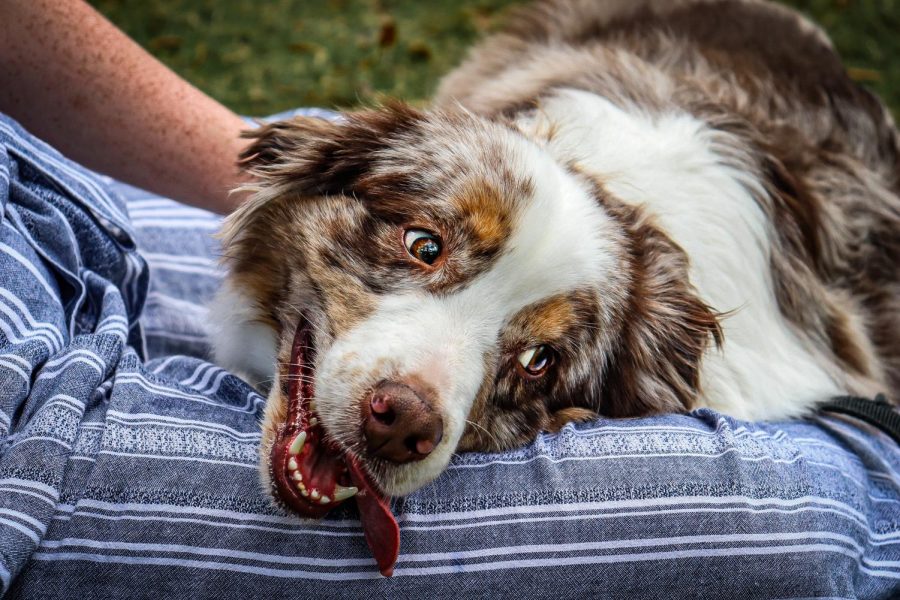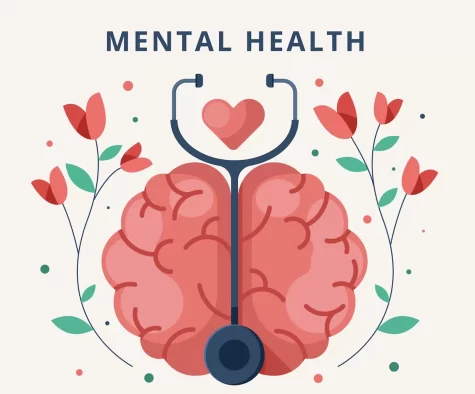A Student’s Best Friend: Stetson Pets, Mental Health, and COVID-19
How the Pandemic Has Affected the Relationship Between Humans and Their Pets
You’re halfway through your 9:45 a.m. class on a Monday morning, and you still haven’t completely woken up. As you glance through the Zoom squares of everyone desperately trying to appear as if they are paying attention, you notice someone has sent a message in the chat which says: “aljblejflrbb.” Amidst your confusion, you see a cat walk across the screen, and it all makes sense.
For the most part, pets are our unproblematic best friends. There’s no drama, except when they interrupt your Zoom class, and they love you unconditionally, except when you come home smelling like another dog.
Animals can have a profound way of making the day seem a little brighter. Is there a scientific reason for this? What is it about animals that makes people feel better?
According to the American Psychological Association, “The problem of chronic and unhealthy levels of stress is at its worst among college-age students, according to some research. While most adults report experiencing elevated stress due to the COVID-19 pandemic, adults ages 18 to 23 are experiencing the highest stress levels.” Abruptly transitioning to online learning and leaving campus at the start of the pandemic was an unexpected change most college students didn’t know how to handle. Even though many are back on campus this year, mostly online classes and a lack of social events make students feel more isolated than ever.
As a way to combat this high level of stress for the Stetson community, in past semesters, the DuPont Ball Library has brought in PAWS Therapy Dogs, a non-profit organization that brings therapy dogs for students to sit and play with. While this alone a few times a semester isn’t enough to fix college students’ worsening mental health problems, there have been studies that show that animals actually improve our mood: A study published by the National Institute of Health shows that college students experience reduced anxiety and an improved mood after interacting with dogs.
The benefits pets offer humans extends long term as well: “Pet owners, and particularly dog owners, have greater life satisfaction, enhanced self-esteem, reduced levels of loneliness and anxiety, more ambition and more positive moods,” states the Mental Health Foundation.. The effects might simply stem from the responsibilities of owning a pet. Pets can act as a great motivator for their owners. Dogs need to go on walks, and exercise is beneficial to those with depression. Even the small tasks of feeding your pet gives one’s day purpose and a sense of achievement. Ultimately, people feel needed when they have something to care for.
In many of the housing options available at Stetson, students are allowed to have their pets stay with them as long as they fill out an application in advance. Vice President of Campus Life and Student Success Lua Hancock, Ph.D., explained why she thinks it’s important to give students the option of living with their pet on campus: “Pets can be helpful for so many people in providing comfort, companionship and routine. Students bring pets from home that they have had an ongoing relationship with and it brings a wonderful family connection with them,” said Hancock.
Hancock expressed caution however; the responsibility that comes with taking care of a pet is not something everyone should take on: “We do have students who have allergies or anxiety about animals, so we have to meet their needs as well. And we have found that it can be too much for some students to navigate college life and be the sole caretaker for an animal in a college environment, which is different from their home environment.”
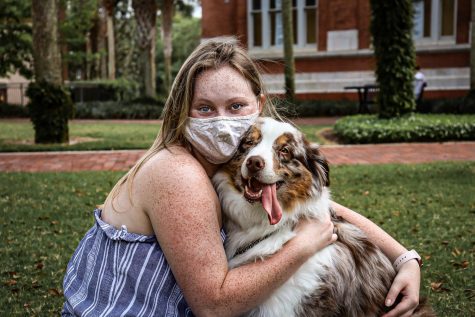
Liza Tananbaum ‘22, has lived with her dog Cash, a miniature Australian shepherd, for almost two years now at Stetson. Tananbaum shared that bringing Cash to Stetson has had a positive impact on her mental health: “Whenever I have a rough day, he is my rock, having…something there that I can vent to, even if he doesn’t understand me, it’s just nice to have. And he’s a very affectionate dog. He loves to give kisses. So even though sometimes it’s gross, it always cheers you up. So it’s been really good,” she said.
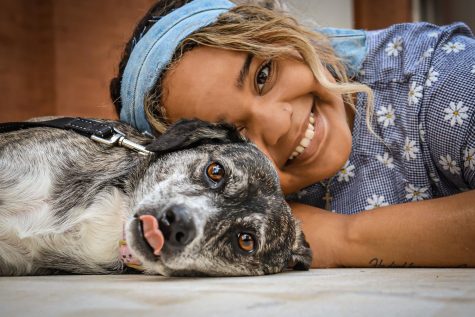
Jaida Garnes ‘24, shared what bringing her dog Misty to Stetson has been like for her. Garnes has had Misty, a Belgian terrier lab mix, for three years. When Jaida found out dorms would be single occupancy this year, she felt encouraged to bring Misty with her, as she is registered as an emotional support animal (ESA). Garnes explained how Misty impacts her mood: “She really does play a role in my mood. If I’m annoyed or something I’ll just be ranting to my dog. I’m like, ‘Misty, you will not believe this.’”
ESAs like Misty, according to the American Kennel Club are defined as providing “emotional support and comfort that helps them deal with challenges that might otherwise compromise their quality of life.” While ESAs are not service animals that receive training, and they are not automatically allowed in public spaces, pets can be registered as emotional support animals with a prescription from a mental health professional. Some universities like Stetson then allow pets on campus.
Victoria Summers ‘22 adopted her seven month old cat Elfie in Oct. of 2020 as an emotional support animal as well. “She’s really easy to take care of. She has a litter box and she’s fine all alone in the room if I have to go to class. It’s nice to have a pet here. Obviously, she’s an ESA, so it’s nice to have her,” she said. “She’s really good at keeping me relaxed. And if I’m stressed out about something, it’s just nice to have her here where I can just take a breath and pet her and play with her. I think it’s really beneficial for my mental health because this time of year is really stressful, and I’m a junior, so it’s a very stressful time of year especially.”
As for how the year has gone having Misty at Stetson, Garnes said, “I have really enjoyed it. It’s really nice to be stressed or something, and then she’s right there. I mean, it’s more work though, and I knew it would be a lot of work. But sometimes it is like, ‘Oh my gosh I do not feel like walking her.’ But you just do it anyway.”
Garnes pointed out how even though having to take care of a dog can be a pain sometimes, it also is a source of motivation for her, which helps especially during the pandemic when it’s harder to get out of bed in the morning. “I think that during the pandemic, a lot of people have kind of been down. I’ve been lonely, but Misty is a good way to keep me motivated too because I have to walk her. So I have to get up, I have to get out of my room. And so it’s kind of been good in that way too. Because she’s forcing me to get up and do things and not to just lay around all day. So it’s been good in that sense, too,” she said.
Tananbaum expressed a similar sentiment: “You know, the biggest reason I brought Cash to campus was because there are times where you are just sitting in your bed or in your room, and the last thing I want to do is get up. Having a dog forces you to get up and go outside and start your day because you have somebody else to take care of. It’s really great, because he also forces me to be social, especially when I was living on campus. I walk him around, and people would come up to me and talk to him. And so it was really nice, because you know, you would just meet people,” she said.
Similar to Tananbaum, Garnes mentioned that she can see how Misty brings happiness not only to her, but also to other people as well: “It’s really cool to see other people. We hear, ‘Oh my gosh,’ that’s really nice. Because I can tell that it makes other people’s days too.”
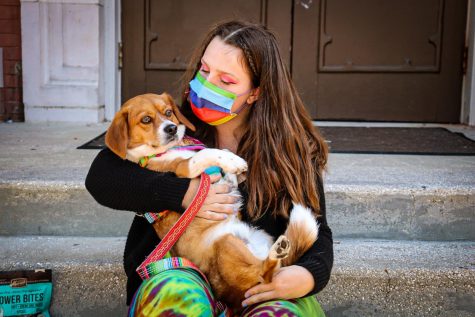
Kelly Ashley ‘24 brought her dog, named Mister Beau, to Stetson, and she credits Mister Beau with keeping her successful: “He’s the reason I’m successful, because he has to go outside every four hours, so I get four walks a day. Sometimes I go out in the courtyard at University Hall so he can just wander around and I do my homework. So, I can have a ton of excuses to be outside,” she said. “And whenever you’re with a group of people, if I have Beau, everybody gets so excited, and they want to pet him and he loves it. It’s awesome.”
“I was stressed out earlier, and I just had a five minute cuddle session with him. Stress gone,” Ashley continued. “He’s my best friend. So yeah, having him here is like therapy really. I think it should be way more common to have dogs.”
Pets have certainly been our constant companion throughout the pandemic, keeping us sane when it feels like the world doesn’t make sense. Science Daily states that “More than 90 percent of respondents said their pet helped them cope emotionally with the lockdown and 96 per cent said their pet helped keep them fit and active.”
The calming effects of pets and the stability they can bring to people’s lives has never been more obvious than during the pandemic. For example, animal adoptions have been increasing. The Washington Post reports that some animal shelters have seen pet adoptions increase 30 to 40 percent last year. Because people are working from home, some have felt that having a pet is more feasible. Relegated to staying at home, adopting an animal is the saving grace to those seeking companionship or to families who need something to distract their kids.
Hancock also shared how adopting a cat has helped her family during the pandemic: “I am so happy that in January of 2020 my family and I got a cat, Jude—my kids like the Beatles—and she has been so great to have around at this time when we are all at home more and could use a few more snuggles,” she said.
Especially during the pandemic, the demand for pets at animal shelters is high and the supply is low. This is a wonderful problem to have, but the negative impact that the pandemic might have on newly adopted animals can’t be ignored. Animals have been having a blast with their owners at home more often with an abundance of play time, head scratches, and walks. But when all of this is over and people return to their jobs in person full-time, pets will face a stark difference in their lives.
Separation anxiety is a serious problem for dogs especially. The Humane Society explains what can cause separation anxiety: being left alone for the first time or after being accustomed to constant human contact, suffering a traumatic event, or changing the family’s routine or structure. Separation anxiety can take different forms like scratching at doors, destructive chewing, howling, barking, and whining, or urination. We’ve seen just how amusing this can get on TikTok as people show just how clingy their pets are, to the point of following their owners into the shower.
Separation anxiety, lack of exercise, and weight gain are all negative effects the pandemic is having on animals, specifically dogs. Animals aren’t built for endless hours of solitary confinement; owner’s will have to prepare their pets for this change.
Ashley said that her dog Mister Beau has had separation anxiety because they live in such close quarters. She hopes to be a veterinarian one day and shared what she has noticed from working at a veterinary clinic: “I actually work at a veterinary clinic. And there’s this thing called ‘COVID puppies’ where during COVID-19 everybody started adopting puppies. And then, those puppies didn’t get socialized for the first critical year of their life, so they come into the vet petrified, completely scared. They’re like, ‘what is this?’ It’s really sad because a lot of the dogs at dog parks nowadays are not very well behaved. They don’t really understand” she said.
Summers discussed the effect the pandemic has had on her cat Elfie, who has gotten used to her being home with her so much. She also brought up how moving back and forth between Stetson and home as a college student has had an impact on her cat: “I got her in October when she was a kitten, so I’ve been home with her since she was a baby. And then we had that long break from Thanksgiving to December where I went home. So I think that the pandemic has had an effect on her with separation anxiety, and also getting used to her living space. She is so young, and having to go back and forth and adjust to new living areas I think also kind of had an effect on her.”
For pets like Mister Beau, The Guardian recommends that owners create frequent separations from their dog, about three to five times a day to help them get used to being alone while also ensuring the dog has its own space where they feel secure and rewarding them when they go in their crate to reinforce the idea that their crate is a happy space. Another important need for dogs is exercise, whether by walking or playing.
Animals seem to be uniquely in tune with humans’ emotions, and this is why they are so great at comforting their owners when they need it. Not only can they tell when humans are stressed, but they also feel their stress, which can leave them more susceptible to sickness, according to the Las Vegas Sun. This is why it is important to be conscious of how they might unload their negative emotions onto their pets, especially when people don’t provide the same comfort to their pet that their pet provides them.
In a time of such tumultuous change, our pets have been there in every possible way over the past year. They calm us and motivate us, and for all they have done for us, it’s important to remember that we have to be there for them as well. The pandemic has affected them too, and as we slowly return to our normal lives, we can’t forget our pets.
Emily Derrenbacker is an Arts & Culture writer for the Reporter and is in her second year at Stetson. She is double majoring in English and social...

Jillian semmel is a sophomore and a digital arts major! Jillian’s career goal is to work as a photographer for a major publication someday and travel...


